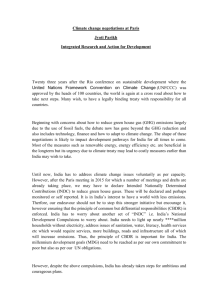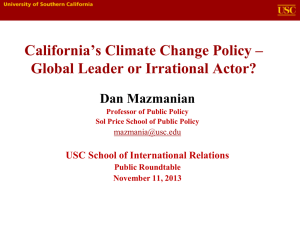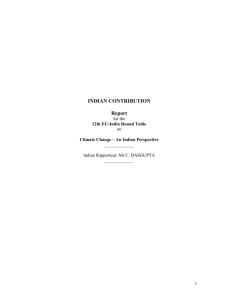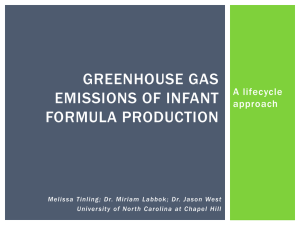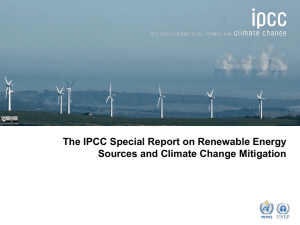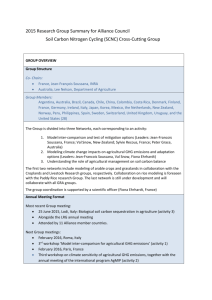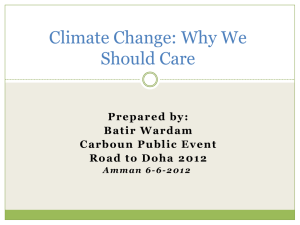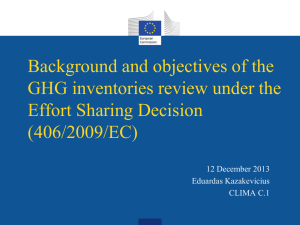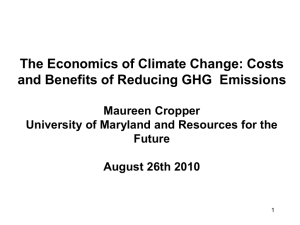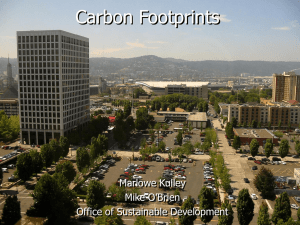Synergy Between Mitigation and Adaptation
advertisement
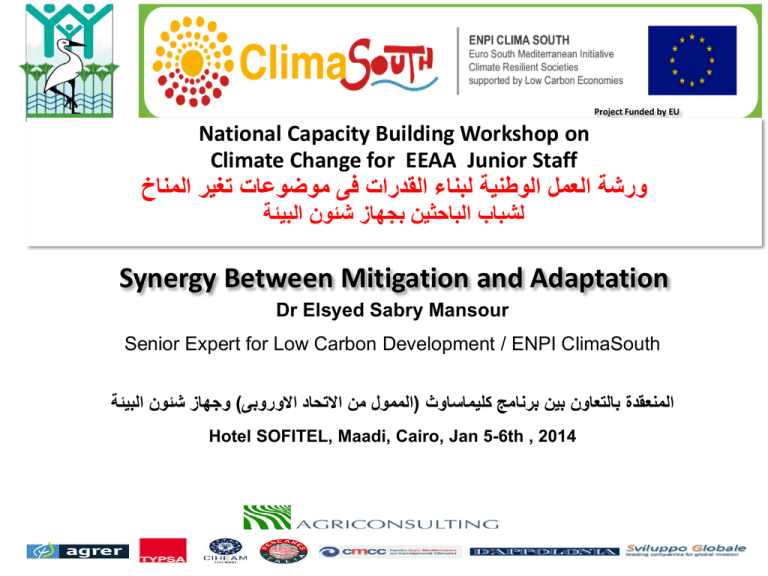
Project Funded by EU National Capacity Building Workshop on Climate Change for EEAA Junior Staff ورشة العمل الوطنية لبناء القدرات فى موضوعات تغير المناخ لشباب الباحثين بجهاز شئون البيئة Synergy Between Mitigation and Adaptation Dr Elsyed Sabry Mansour Senior Expert for Low Carbon Development / ENPI ClimaSouth المنعقدة بالتعاون بين برنامج كليماساوث (الممول من االتحاد االوروبى) وجهاز شئون البيئة Hotel SOFITEL, Maadi, Cairo, Jan 5-6th , 2014 Climate Change in ENP South Region • ENP South region is among the most arid area in the world: the IPCC indentified it as especially vulnerable to climate change because: => Climate change is a risk multiplier with scarcer water resources, climate sensitive agriculture, limited natural resources associated to an increasing economic development and demographic growth along the coastal zones in particular. Impact of climate-related disasters across the Arab Region More floods Source: "Adaptation to a changing climate in the Arab Countries" World Bank Climate change impacts The IPCC projects (95% certainty): ₒ 2 C increase by 2050 ₒ 4 C increase by 2100 Changes in precipitation patterns Stronger winds (more sand storms) Combined effects of temperature increase and precipitation variability will increase the occurrence of droughts Maghreb: Droughts have increased from 1 event every 10 years in early 20th century to 5-6 events every 10 years today Global models predict sea levels rising from: 0.1 to 0.3 m by 2050 0.1 to 0.9 m by 2100 1.0 meter sea level rise would affect: 3.2% of MENA’s population 1.5% of the regional GDP 3.3% of wetlands Egypt: A 1.0 m sea level rise in the Nile Delta would affect 10% of the population, and 13% of Egypt’s agriculture Low carbon emissions patterns in the ENP South Region GHG emissions differ by sectors, and from one country to another Algeria Tunisia Evolution of Gross GHG emissions by sector Evolution of Gross GHG emissions by sector 104.79 MtCO2eq 100% 100% 37.3 MtCO2eq 28.87 MtCO2eq 111.31 MtCO2eq 3.50% 5.00% 12.90% 9.30% 4.60% 9.70% 90% 12.40% 90% 5.40% 80% 5.60% 80% 11.50% 70% 4.70% 70% 4.50% 60% 60% 50% 50% 20.20% 20.90% 10.50% 9.80% 40% 40% 74.60% 67.00% 30% 30% 55.00% 52.90% 20% 20% 10% 10% 0% 0% 1994 31/10/13 Energy Industrial processes 2000 Agriculture Land use, land use change and forestry 1994 Waste Energy Industrial processes 2000 5 Agriculture Land use, land use change and forestry Waste Low carbon emissions patterns in the ENP South Region (2) Egypt GHG emissions (net): 1990: 117 MtCO2eq GHG emission growth rate: 2008: 288 MtCO2eq (est.) Main emitting sectors: Energy Agriculture Industrial processes Waste The fastest growing 5.1% (1990-2008) sources: waste and industrial 61% 16% 14% 9% processes Jordan GHG emissions (net): 1994: 13.8 MtCO2eq 2000: 20.1 MtCO2eq Main emitting sectors: Energy Waste Industrial processes GHG emission growth rate: 6.5% (1994-2000) 74% 13% 11% Mitigation versus Adaptation? Synergy is the interaction of adaptation and mitigation measures so that their combined effect is greater than the sum of their effects if implemented separately. Synergies : Added value Very often, clean energy is regarded as a «mitigation» activity, while water resources management is considered as an «adaptation measure». But : Clean energy & water resources management together offer a good example of synergy and trade-offs between mitigation and adaptation measures which could be overlooked in a strict segregation among adaptation and mitigation stand alone actions => Win Win situation Potential sectors for synergies Review of national priorities globally Energy, agriculture and the water sector (including coastal management) provides relatively high potential for both mitigation and adaptation measures Source : Scoping study on financing adaptation-mitigation synergy activities, Nordic Council of Ministers, 2013. Examples of Low carbon emissions measures boosting climate resilience Solar energy supporting water resources sector in Jordan Energy efficiency in the building sector in Morocco The case of the Jordan Valley The greatest contributor to GHG emissions in Jordan is the electricity sector; the greatest climate vulnerability is water supply. The latter issue exacerbates the former: the electricity consumption for water pumping is already high, and will further grow with climate change Jordan receives a high amount of solar radiation each year (20.4 MJ/m2) making photovoltaic electricity a viable renewable energy option. Water technologies, such as deep groundwater pumping, are very energy intensive : meeting those energy needs in a resilient, carbon-neutral manner is essential A solution: Solar Pumps project in Jordan Low Carbon Development direct benefits: Expected CO2 reduction:4501,575 ton CO2/year Annual Econmic Savings for 243 SWP= saving of total annual consumption of fossil fuel+electricity= 434700 JOD = $613361 Socio/economic co-benefits: Stability for residents in the Jordan Valley, encouraging farmers to adopt such actions; job creation from temporary construction jobs; gives local communities opportunity for economic development ; Increase the income of the farmers by $ 2526/unit (average unnual fuel cost) Environmental co-benefits: Air pollution reduction thus improving health conditions Another problem: GHG emissions from Residential Buildings In 1990, the residential, commercial and institutional buildings sector was responsible for roughly 1/3 of global energy use and associated GHG emissions (all countries together). This sector is offering a rapid deployment of new technologies to: 1)reduce energy use in building equipment (appliances, heating and cooling systems, lighting, plug loads, including office equipment); 2)reduce heating and cooling energy losses through improvements in building thermal integrity. Energy Efficiency in Residential Buildings in Morocco Objective: Adoption of measures to stimulate the uptake of solar hot water systems and accelerate the adoption of efficient lighting (CFL) The context in Morocco: • Solar water heater market development is aiming at reaching an installed capacity of approximately 1.7 million m2 by 2020. • Morocco aims to distribute some 23 million CFLs to reduce peak load. • The "20-20" initiative: households that achieve a 20% reduction in energy usage benefit from an additional 20% rebate on energy bills. 14 Low Carbon Development direct benefits => Mitigation Expected CO2 reductions: • • • SWH = 0.45-0.9 TCO2/100 Liter/year Incandescent light bulbs (standard) to CFL = 45 gCO2/KWh PV (Crystal) = 43 kg CO2/M Wh, PV (Thin Film) = 21 kg CO2/MWh Sustainable development co-benefits => Climate Resilience • Social: Job opportunities (manufacturing, installation, maintenance and operation) • Economic: from energy savings (Values vary with location, orientation of modules, technology choices, size of installation actual installation and operating costs) • Environmental: Reduce air pollution, hence improving health conditions Building resilience with GHG emissions reduction Technological and non-technological responses can mitigate the amount of GHGs in the atmosphere . Innovative technologies are making • buildings more energy efficient, • allowing for the harnessing of renewable energy and • reducing emissions from transportation sources. Non-technological responses include taking actions to preserve and expand carbon sinks. • natural systems that sequester carbon from the atmosphere by storing / carbon-offset (forests for example) Effective climate change policy Horizontal approach: Low Carbon Economy Supporting Climate Resilient Society OR Climate Resilient Society Built on Low Carbon Economy => A cross-sectoral dialogue to allow implementing an effective climate change policy at various levels (national, regional, local) How to move towards a closer dialogue? Taking climate change into account at every level: • Region specific approaches: identify joint strategies taking into account the regional scale of impacts, type of risks and similar/complementary options; • National /sectoral level: better integration of climate change impacts and risk management into national agriculture, health, water resources management policies. • Local level: Local development plan at community levels to enhance resilience of vulnerable population/ecosystems.

